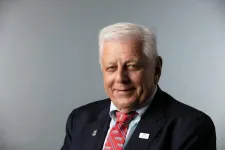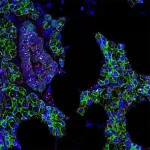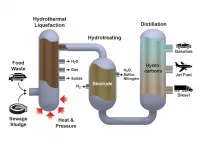(Press-News.org) Researchers have used the evidence of pumice from an underwater volcanic eruption to answer a long-standing mystery about a mass death of migrating seabirds.
New research into the mass death of millions of shearwater birds in 2013 suggests seabirds are eating non-food materials including floating pumice stones, because they are starving, potentially indicating broader health issues for the marine ecosystem.
The research which was led by CSIRO, Australia's national science agency, and QUT, was published in the journal Marine Ecology Progress Series, that examined a 2013 seabird "wreck" in which up to 3 million short-tailed shearwaters died.
The lead author on the paper and CSIRO and IMAS-UTas researcher Dr Roman said there was much discussion in the scientific community about the causes of mass mortality of seabirds which are often found with plastic and other non-food items in their stomach.
"We found that in the instance of the shearwater bird deaths in 2013, these birds were starving, and in their starved state had reduced prey discrimination," Dr Roman said.
"Our study investigates the chicken-and-egg dilemma - do animals starve from eating non-food or do animals eat non-food because they are starving?""
Sea birds are widely considered to be indicators of the health of a marine ecosystem and mass mortalities can indicate changing food webs and ecological conditions.
Short-tailed shearwaters (Ardenna tenuirostris), which were the subject of the study, migrate from Australia in April to the North Pacific and return late in the year.
Necropsies of 172 seabirds recovered from beaches along the New South Wales and Queensland coast found 96.7 per cent of birds had ingested pumice or plastic.
The research team, including Dr Natalie Bool (IMAS-UTas), Leah Gustafson (QUT) and Dr Kathy Townsend (USC), used satellite systems to track the 2013 shearwater migration and overlayed that onto locations of the pumice raft produced by the 2012 Havre eruption in the Kermadec arc north of New Zealand.
QUT's Associate Professor Bryan has been studying pumice rafts for over 20 years and recently has been tracking the impact of another giant pumice raft from a 2019 underwater eruption near Tonga that landed along the Australian coastline last year.
"We proposed that a short time period between non-food ingestion and death would indicate that birds were already starving at the time of non-food ingestion, and a starving state would be reflected by poor body condition and reduced muscle mass," Professor Bryan said.
"Death after a longer period would indicate that birds starved following ingestion of non-food."
Professor Bryan said detailed information about the route of the pumice raft was an integral part to determining the answer of where the birds had consumed the pumice.
"We combined the tracking information data of the short-tailed shearwaters, using location tags on migrating birds, and the geological signature of the ingested pumice," Professor Bryan said.
"By October 2013 when the shearwaters were returning to Australia on their annual migration from the North Pacific, the floating pumice was now located along their flight path as they approached Australia."
By determining when the birds ate the pumice, and their physical condition at the time, the researchers were able to conclude that the birds were already starving when they ate the pumice, and they had ingested the pumice about 12 to 41 hours before death.
"With a projected increase in challenging times for wildlife because of threats such as climate change, marine pollution and over exploitation of resources, this study has implications for mass mortalities and exacerbation of existing threats to marine species," Dr Roman said.
It was the coming together of researchers into seabirds and volcanoes and pumice rafts, apparently unrelated phenomena, and the crossing of science discipline boundaries that has been able to help solve this chicken-and-egg dilemma.
INFORMATION:
The research team included scientists from CSIRO, QUT, Institute for Marine and Antarctic Studies and University of the Sunshine Coast.
A coordinated global effort to reduce the production of greenhouse gas emissions from industry and other sectors may not stop climate change, but Earth has a powerful ally that humans might partner with to achieve carbon neutrality: Mother Nature. An international team of researchers called for the use of natural climate solutions to help "cancel" produced emissions and remove existing emissions as part of a comprehensive plan to keep global warming below 1.5 degrees Celsius -- the point at which damage to human life and livelihoods could become catastrophic, according to the United Nations' Intergovernmental Panel on Climate Change.
The researchers published their invited views on March 24 in ...
Recently, the team led by Professor WU Changzheng from School of Chemistry and Materials Science from University of Science and Technology of China (USTC) in cooperation with the team led by Prof. WU Hengan from School of Engineering Science, realized the homogenization of surface active sites of heterogeneous catalyst by dissolving the electrocatalytic active metal in molten gallium. The related results have been published on the Nature Catalysis on March 11th.
Due to the existence of various defects and crystal faces, the active components on the surface of heterogeneous catalysts are often in different ...
Tsukuba, Japan - Physical exercise has long been prescribed as a way to improve the quality of sleep. But now, researchers from Japan have found that even when exercise causes objectively measured changes in sleep quality, these changes may not be subjectively perceptible.
In a study published this month in Scientific Reports, researchers from the University of Tsukuba have revealed that vigorous exercise was able to modulate various sleep parameters associated with improved sleep, without affecting subjective reports regarding sleep quality.
Exercise is ...
Lugano, Switzerland; Denver, CO, USA, 25 March 2021 - Clinical activity with a second drug inhibiting KRASG12C confirms its role as a therapeutic target in patients with advanced non-small-cell lung cancer (NSCLC) harbouring this mutation, according to results from a study with the KRASG12C inhibitor adagrasib reported at the European Lung Cancer Virtual Congress 2021. (1)
"As we strive to identify the oncogenic driver in more and more of our patients with NSCLC, it becomes critical that we develop therapies that can target these identified oncogenic drivers," said lead author Gregory Riely, from Memorial Sloan Kettering Cancer Center, New York, ...
For the first time, activation of nuclear receptor coactivator 3 (NCOA3) has been shown to promote the development of melanoma through regulation of ultraviolet radiation (UVR) sensitivity, cell cycle progression and circumvention of the DNA damage response. Results of a pre-clinical study led by Mohammed Kashani-Sabet, M.D., Medical Director of the Cancer Center at Sutter's California Pacific Medical Center (CPMC) in San Francisco, CA were published online today in Cancer Research, a journal of the American Association for Cancer Research.
"Our research suggests a previously unreported mechanism by which NCOA3 regulates the DNA damage response and acts as a potential therapeutic target in melanoma, whereby activation ...
Durham, NC - Depletion of a certain type of stem cell in the womb lining during pregnancy could be a significant factor behind miscarriage, according to a study released today in STEM CELLS. The study, by researchers at Warwick Medical School, University of Warwick, Coventry, England, reports on how recurrent pregnancy loss is a result of the loss of decidual precursor cells prior to conception.
"This raises the possibility that they can be harnessed to prevent pregnancy disorders," said corresponding author Jan J. Brosens, M.D., Ph.D., professor of obstetrics and gynecology at Warwick Medical School (WMS).
The womb lining - or endometrium - is a ...
Perhaps the best hope for slowing climate change - capturing and storing carbon dioxide emissions underground - has remained elusive due in part to uncertainty about its economic feasibility.
In an effort to provide clarity on this point, researchers at Stanford University and Carnegie Mellon University have estimated the energy demands involved with a critical stage of the process. (Watch video here: https://www.youtube.com/watch?v=-ZPIwwQs9aM)
Their findings, published April 8 in Environmental Science & Technology, suggest that managing and ...
Smoking cigarettes causes 480,000 premature deaths each year in the United States, due mainly to a two-fold risk of cardiovascular disease and a 20-fold risk of lung cancer. Although smoking rates have declined dramatically, there are currently 35 million smokers in the U.S.
In a commentary published in the Ochsner Medical Journal, Charles H. Hennekens, M.D., Dr.PH, senior author, the First Sir Richard Doll Professor, and senior academic advisor in the Schmidt College of Medicine at Florida Atlantic University, and colleagues, highlight how failure to institute smoking cessation in hospitalized patients is a missed opportunity to avoid many premature deaths.
Each year in the U.S., ...
An international team led by scientists at the National Institutes of Health and the University of North Carolina at Chapel Hill, has found evidence that SARS-CoV-2, the virus that causes COVID-19, infects cells in the mouth.
While it's well known that the upper airways and lungs are primary sites of SARS-CoV-2 infection, there are clues the virus can infect cells in other parts of the body, such as the digestive system, blood vessels, kidneys and, as this new study shows, the mouth. The potential of the virus to infect multiple areas of the body might help explain the wide-ranging symptoms experienced by COVID-19 patients, including oral symptoms such as taste loss, dry mouth and blistering.
Moreover, the findings ...
RICHLAND, WASH.--A large-scale demonstration converting biocrude to renewable diesel fuel has passed a significant test, operating for more than 2,000 hours continuously without losing effectiveness. Scientists and engineers led by the U.S. Department of Energy's Pacific Northwest National Laboratory conducted the research to show that the process is robust enough to handle many kinds of raw material without failing.
"The biocrude oil came from many different sources, including wastewater sludge from Detroit, and food waste collected from prison and an army base," said John Holladay, a PNNL scientist and co-director of the joint Bioproducts Institute, a collaboration between ...




